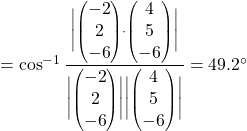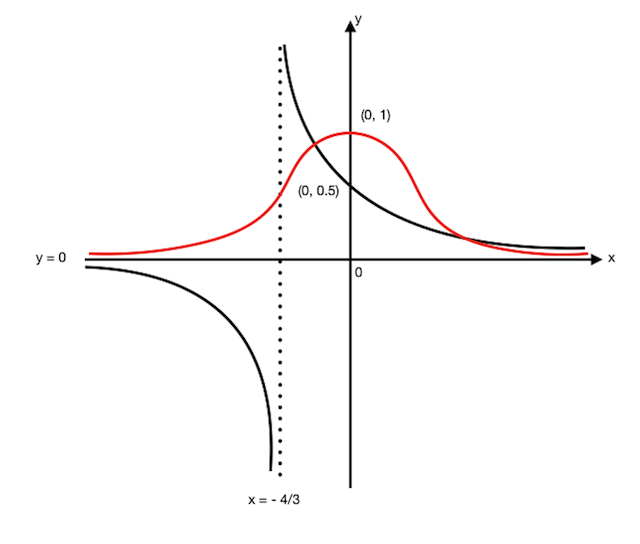All solutions here are suggested. Mr. Teng will hold no liability for any errors. Comments are entirely personal opinions. Sorry, due to copyrights issues, I cannot share the paper.
Numerical Answers (workings/explanations are after the numerical answers.)
Question 1: 
Question 2: ![]()
Question 3: ![]()
Question 4: 
Question 5: ![]() ; refer to solutions below for explanation.
; refer to solutions below for explanation.
Question 6: ![]()
Question 7: ![]()
Question 8: ![]()
Question 9: ![]()
Question 10: ![]()
Question 11: ![]()
(i) [Maximum marks: 2]

(ii) [Maximum marks: 2]
Required angle 
Note/ Comment: For (i), if students simplified, it is ok since the questions simply asked for a vector normal to the plane.
![]()
Differentiating with respect to ![]() ,
,
![]()
Let ![]()
![]()
![]() , where
, where ![]()
Note/ Comment: Slightly tedious but fully manageable. A more elegant approach will be to consider
![]()
![]()
and differentiate from here.
(i) [Maximum marks: 3]
![]()
![]()
![]()
![]()
![]()
![]()
![]()
(ii) [Maximum marks: 4]
![]()
![]()
![]()
Note/ Comment: Quite a standard question. Students can verify their answers using the standard series too.
![]()
(i) [Maximum marks: 4]
We can first convert all the given complex numbers to exponential form.
![]()
![]()
![]()
![]()
![]()
![]()
![]()
*Another approach is to straightaway solve for ![]() and
and ![]() .
.
(ii) [Maximum marks: 3]
![]()
![]()
![]()
![]()
![]()
![]()
![]()
![]()
![]()
![]() , and
, and
![]()
* Another approach is to observe that ![]()
Note/ Comment: This can be tedious if the student did not use exponential form to get around things. For (ii), the question has stated “possible values” which is a hint that there is more than one answer to be expected. Aside from it, students should use GC to check their answers.
(i) [Maximum marks: 2]
We have that ![]() , so
, so ![]() is parallel to
is parallel to ![]() and
and ![]() where
where ![]() is a scalar.
is a scalar.
(ii) [Maximum marks: 3]
![]()
R is a set of points lying on a line that passes through position vector ![]() and is parallel to direction vector
and is parallel to direction vector ![]() , where
, where ![]() is a scalar parameter.
is a scalar parameter.
(iii) [Maximum marks: 4]
![]()
R is a set of point lying on a plane that passes through position vector ![]() and is perpendicular to normal vector
and is perpendicular to normal vector ![]() , where
, where ![]() units is the shortest displacement R is from the origin.
units is the shortest displacement R is from the origin.
Note/ Comment: Quite a standard question, from the specimen paper and also from 2017 A’levels paper. Students should be able to answer this comfortably.
![]()
![]()
![]()
By comparing the coefficients, ![]()
![]()
![]()
![]()
![]()
![]()
Other root ![]() and
and ![]() and
and ![]()
Note/ Comment: Actually this question did not prohibit the GC, so the last part could be done easily.
(i) [Maximum marks: 1]
![]()
(ii) [Maximum marks: 4]
![]()
![]()
![]()
![]()
(iii) [Maximum marks: 4]
![]()
![]()
![]()
![]()
![]()
![]()
Note/ Comment: Students should use GC to check their answers.
(a)(i) [Maximum marks: 2]![]()
![]()
![]()
(a)(ii) [Maximum marks: 3]
![]()
![]()
![]()
(b)(i) [Maximum marks: 2]![]()
![]()
(b)(ii) [Maximum marks: 5]
![]()
![]()
![]()
![]()
![]()
![]()
Smallest possible ![]() .
.
Note/ Comment: Standard question.
(i) [Maximum marks: 1]
Consider the lines ![]() and
and ![]() , since the gradient
, since the gradient ![]() , where
, where ![]() is the angle the line makes with the horizontal and the two lines
is the angle the line makes with the horizontal and the two lines ![]() and
and ![]() are perpendicular, i.e.,
are perpendicular, i.e., ![]() radians spaced from each other. We have that
radians spaced from each other. We have that ![]() .
.
(ii) [Maximum marks: 3]
![]()
![]()
![]()
![]()
![]()
![]()
![]()
![]()
Since ![]() , required set
, required set ![]()
(iii) [Maximum marks: 3]

Note: Right side of the graph. The asymptote is y=0, I do not know why wordpress cut it off. 🙁
(iv) [Maximum marks: 5]
Using GC, ![]()
![]()
![]()
![]()
(i) [Maximum marks: 2]
![]()
(ii) [Maximum marks: 4]![]()
![]()
![]()
![]() , where
, where ![]() is an arbitrary constant.
is an arbitrary constant.
In the long run, ![]() , The number of sheep will decrease and approach 0.
, The number of sheep will decrease and approach 0.
(iii) [Maximum marks: 2]
![]()
(iv) [Maximum marks: 4]
![]()
![]()
![]() where
where ![]() is an arbitrary constant.
is an arbitrary constant.
![]()
(v) [Maximum marks: 2]
In the long run, ![]()
![]()
Note/ Comment: This question is quite difficult to interpret, but once you understand, it should be manageable.
(i) [Maximum marks: 3]
Let ![]() and
and ![]() , then
, then ![]()
![]()
![]()
![]()
![]()
![]()
![]()
(ii) [Maximum marks: 3]
Differentiate with respect to ![]() ,
,
![]()
Let ![]()
![]()
![]()
(iii) [Maximum marks: 1]
There are other external factors such as the strength of the kick, or wind, etc.
Note: I personally cannot think of a mathematical reason. Please share with me if you do. So I guess anything logical is fine.
(iv) [Maximum marks: 3]
![]() .
.
When ![]()
(v) [Maximum marks: 2]
![]()
![]()
![]()

I wanna read the comment
you will have better luck at reddit
For the DE question, if i got the equation wrong but the steps in ii correct and deduced that overtime population approaches 0, will i get any mark.
you should. But the model will probably be wrong since math in general does not carry ecf.
does a wrong DE but correct way of solving DE get marks, thanks!
Given the marks distribution for the question, quite tough.. :/ Since the method to solve the DE was variable separable.
regarding question 2, if i did all steps correctly just during differentiation i carelessly left out the dy dx on the product side of the equation, will there be ecf? or will the 6 marks just fly away like that 🙁 thank you for your reply and the answers!
it won’t just fly away. if your method to find tangents, etc are correct. there will be marks.